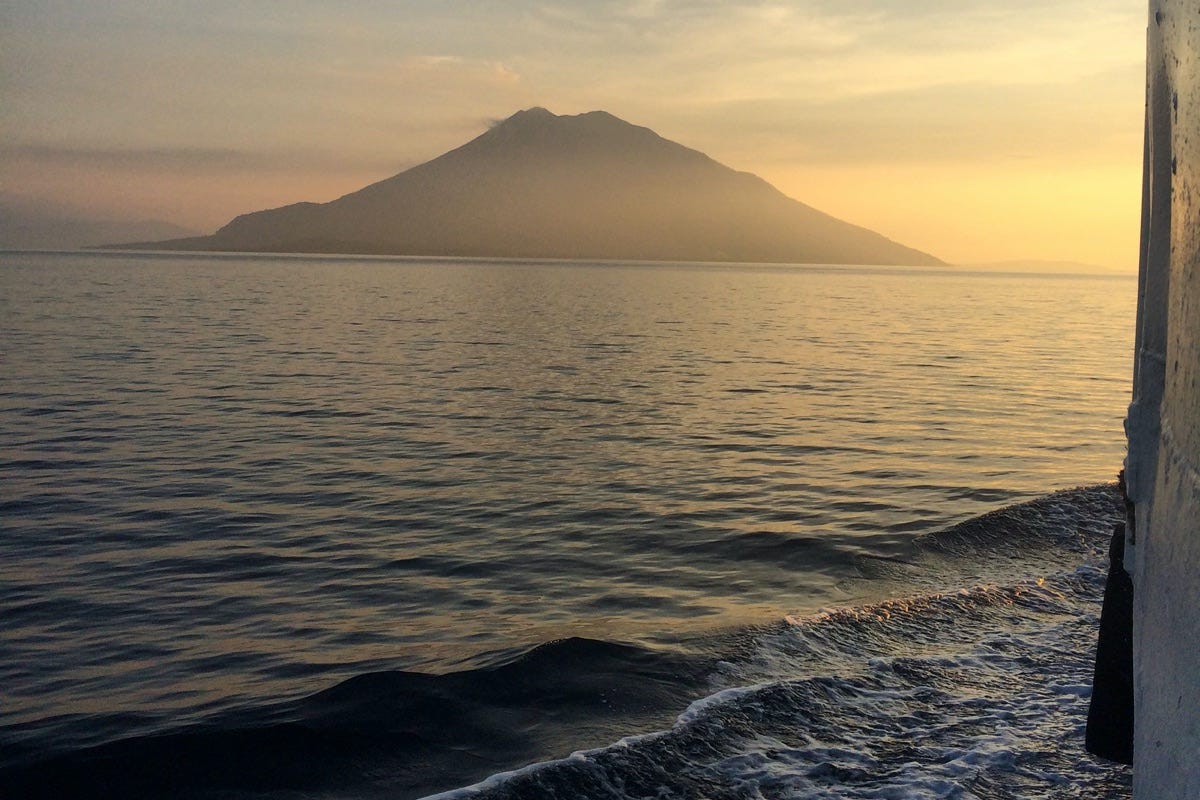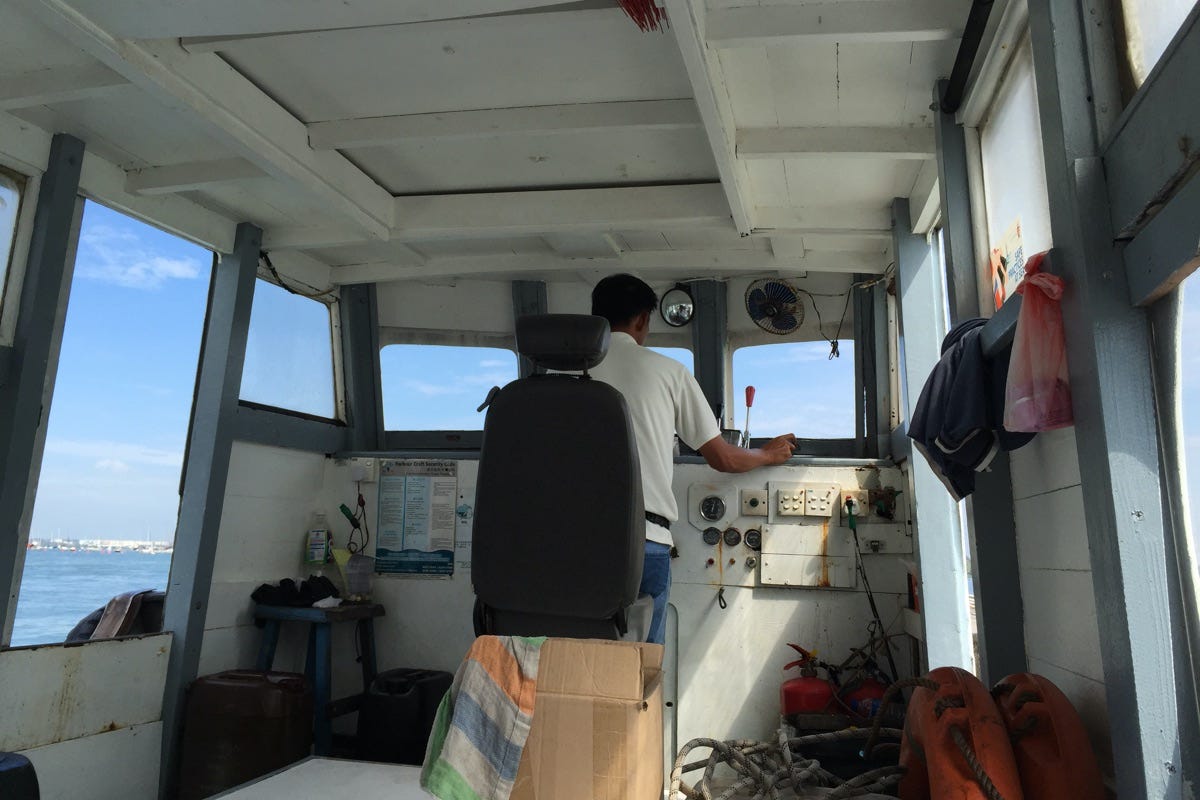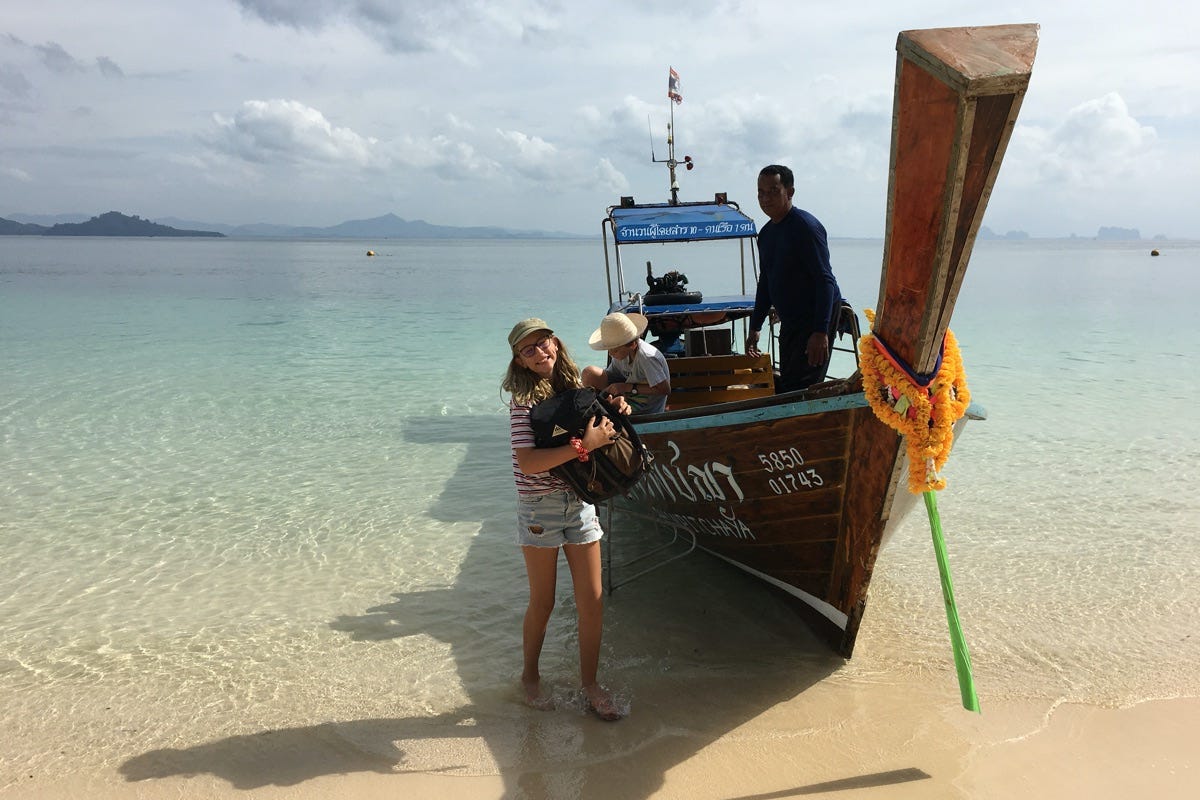A couple of years ago I was in Eastern Indonesia and I caught a ferry from Baranusa on Pantar to Lewoleba on Lembata. The trip is roughly 100 km and it took around ten hours or so. It was slow travel.
The boat is a typical mid–sized Indonesian vessel—a mixed purpose RORO ferry with plenty of space to roam. There are only a couple of vehicles on board so it isn’t long before the car deck transforms into a picnic area of sorts. Mats are unrolled, food appears, and families set up for the slow, smooth, ride west.
Lembata slides past. Photo: Stuart McDonald.
Outside, as Pantar fades to the east, the first of Lembata’s great volcanoes looms. At a tad over 1,500 metres, Ili Uyelewun is a baby by Indonesian standards, but flush to the ocean, and the sky a crystal blue, it is magnificent. It takes us an hour or so before the volcano is by our side. I’m on the ferry’s upper deck, feet dangling over the side, looking across the glassy water towards it.
Though it took us hours to reach the midpoint, the moment passes fast. I’m chatting to some other passengers, two guys from Kupang, then I look back towards it, and I realise it is falling behind us. An hour later, it is fading away. I look west—if I squint, I can just see the shadow of the next peak, Lembata’s star attraction, Lewotolo, better known as Ile Api. About ten metres shorter than Ili Uyelewun, even with the afternoon haze I can make out its beautiful lines.
It will take us another seven hours to be opposite it.
Approaching Ile Api. Photo: Stuart McDonald.
I’ve written before on how train is my favourite way to travel, but boats come a close second. As with the rails, at sea you can get up and wander around, live your life and so on. All the time moving from one place to another. Far preferable to being wedged into an aircraft or bus seat.
In archipelago Indonesia, the ferries are lifelines connecting one island to another. Sometimes, connecting towns on the same island—as I wrote about here on Pantar. Even without an archipelago, you’ll find “things that float” across Southeast Asia.
On the Chindwin. Photo: Stuart McDonald.
I’ve written before of a two day river boat trip in Burma from Monywa to Mawleik. As we call into small villages along the Chindwin, a dozen sampans paddle out to meet us. They pull up along side, disgorging throngs selling noodles, cigarettes and warm beer. The boat moors at night (Hello Kalewa!), but we’re still on the river at sunset and back on the water for dawn. Fast, smooth waters run past as we chug upriver. We sit beside the captain at the prow, Burma spread out in front of us, the view obscured only by fluttering flags.
On the Vomit Comet. Photo: Stuart McDonald.
In Cambodia, while it no longer runs (to my knowledge), the “vomit comet” was a river speedboat used in the open seas from Koh Kong to Sihanoukville. Take my word for it, in rough weather, it earned its nickname. Long, narrow and squat, the cabin below was not for the squeamish. Instead you’d sit on the roof, in season with a mountain of backpacks in the middle. In rough weather, you’d need to hang on tight. They’d break the trip at Koh Sdach, where a large ice–making factory was the primary attraction.
Easily the most terrifying way to travel on the Mekong!
Riverine Laos, a country where for decades its rivers were the highway of choice. An improving road network and plenty of dams have put some boat trips into past tense, but others still run. The slow boat from Huay Xai to Luang Prabang, taking two days and a night, remains one of the best boat trips in Southeast Asia. Do it while you still can. Smaller rivers, smaller boats. Almost always big enough to fit a scooter on though. Be it slicing your way up the Nam Kading, down the Nam Ou or even paddling up the Nam Tha, every river is different and rewarding in its own way.
Wildlife spotting on the Kinabatangan. Photo: Sally Arnold.
Like Laos, Malaysia is no slouch when it comes to river travel. It is my favourite way to approach Taman Negara National Park (do not take the minibus!). In the east, the Kinabatangan trip combines the pleasure of boat travel with some of Malaysia’s most endangered wildlife.
I’m on a bumboat! Photo: Stuart McDonald.
If you’re travelling with kids, and find yourself in Singapore, take them on a bumboat, because, well, it is a bumboat. A bumboat is also an ideal way to get off the main island and throw yourself into the wilderness. I remember the first time I caught the cute little boat across to Pulau Ubin. Leaving behind the glass and brass of the city for natural beauty. Abandoned granite quarries, now reservoirs, birds everywhere. Perfectly manicured nature—Singapore–style.
Fun times with the kids. Photo: Stuart McDonald.
Thailand offers a mix. There are river trips like the Kok River in the north—touristy, but deservedly popular. The country comes into its own though, in the south. Long tails. Long, lumbering, beautiful and noisy as hell, they’re a great way to explore the southwest islands. It seems a million years ago I was there with the kids and we chartered longtails to hop from island to island. Sometimes the trips were long. I’d snooze while the kids counted birds and boats and asked me “are we there yet” too many times to count. Mostly we’d pull up on the sand, gliding down a channel or, through the crystal water over the remains of the house reef. No pier, no worries—there is something special about going sand to boat to sand. And hey, with a chartered longtail you can make your own adventure. Pull up at say Ko Lao Liang to snorkel in the early morning, with not another soul there.
Small river? Need a small boat. At Xeo Quyt. Photo: Stuart McDonald.
Which leaves me with Vietnam. To my mind you can’t go past the Delta. There’s sampans and cargo boats and speedboats and longer distance ferries. No two boats, nor the resulting experiences are the same. A country within a country, crisscrossed by hundreds of canals and tributaries. And there are boats on every single one of them. My all time favourite was a two day trip from Mỹ Tho to Tân Châu by the Cambodian border (near Châu Đốc). Sunset, sitting on the roof, surrounded by baskets of fruit, feet up, wind in our faces. At the other end of the stick, still in the Delta, in a sampan this time, being paddled through the dense jungle at Xeo Quyt. How could anyone have fought a war in this?
Then there’s the people you meet—regardless of which country you’re in. There’s something camaraderie–like about boat travel. Perhaps it is just that all on board have so much time on their hands. People are going to walk up and say hello. Instant coffees are shared, perhaps some noodles. A few words as we stumble through each others’ languages. The phones come out, details are swapped.
I’m still Facebook friends with the two guys from Kupang.


















